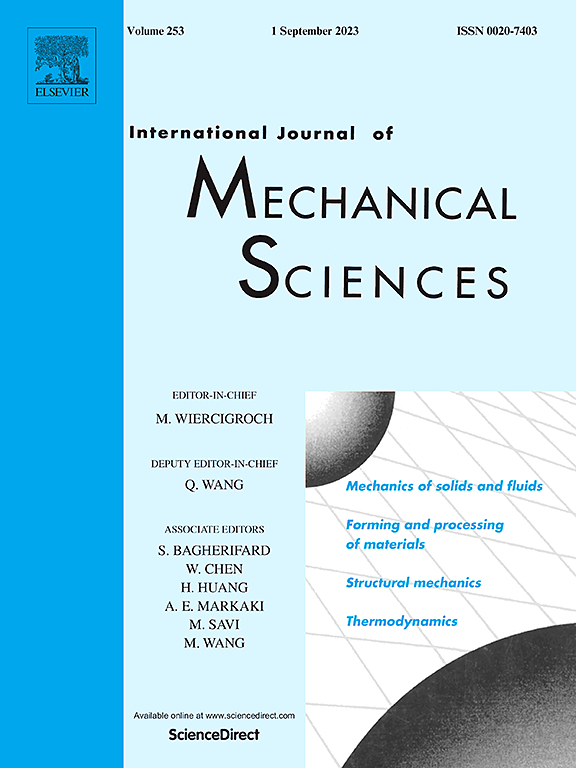Obliquely propagating incident SH waves in periodic hard-magnetic soft laminates
IF 7.1
1区 工程技术
Q1 ENGINEERING, MECHANICAL
International Journal of Mechanical Sciences
Pub Date : 2025-02-01
DOI:10.1016/j.ijmecsci.2025.109945
引用次数: 0
Abstract
In this paper, we present a theoretical modeling framework to investigate the influence of the nonlinear finite magneto-deformation on the propagation of shear horizontal (SH) waves at oblique angles in periodic hard-magnetic soft laminates. The equations governing the finite magneto-deformation and superimposed incremental SH waves are derived using the nonlinear field theory of hard-magnetic soft materials and its incremental magneto-elasticity theory. The constitutive response of the hard-magnetic soft laminate phases is described using an incompressible hyperelastic Gent model in conjunction with the ideal hard-magnetic soft material model. The Finite Element Method, along with Bloch–Floquet periodic boundary conditions, is utilized to solve the incremental SH wave equations. The numerical results demonstrate that the tunability of the SH wave bandgaps depends on various factors, including the applied external magnetic field, the direction of the remenant magnetization, the volume fractions of the laminate phases, and the incident angle of the SH wave. The numerical findings reported here are expected to provide a strong foundation for designing soft intelligent phononic structures with actively and remotely controlled tunable bandgaps.

求助全文
约1分钟内获得全文
求助全文
来源期刊

International Journal of Mechanical Sciences
工程技术-工程:机械
CiteScore
12.80
自引率
17.80%
发文量
769
审稿时长
19 days
期刊介绍:
The International Journal of Mechanical Sciences (IJMS) serves as a global platform for the publication and dissemination of original research that contributes to a deeper scientific understanding of the fundamental disciplines within mechanical, civil, and material engineering.
The primary focus of IJMS is to showcase innovative and ground-breaking work that utilizes analytical and computational modeling techniques, such as Finite Element Method (FEM), Boundary Element Method (BEM), and mesh-free methods, among others. These modeling methods are applied to diverse fields including rigid-body mechanics (e.g., dynamics, vibration, stability), structural mechanics, metal forming, advanced materials (e.g., metals, composites, cellular, smart) behavior and applications, impact mechanics, strain localization, and other nonlinear effects (e.g., large deflections, plasticity, fracture).
Additionally, IJMS covers the realms of fluid mechanics (both external and internal flows), tribology, thermodynamics, and materials processing. These subjects collectively form the core of the journal's content.
In summary, IJMS provides a prestigious platform for researchers to present their original contributions, shedding light on analytical and computational modeling methods in various areas of mechanical engineering, as well as exploring the behavior and application of advanced materials, fluid mechanics, thermodynamics, and materials processing.
 求助内容:
求助内容: 应助结果提醒方式:
应助结果提醒方式:


